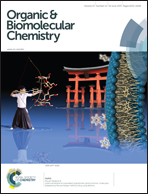Trienamine catalysis for asymmetric Diels–Alder reactions of 2,4-dienones: a theoretical investigation†
Abstract
The mechanism and origin of the selectivity of asymmetric Diels–Alder reactions of 2,4-dienones (R1) by trienamine catalysis is investigated at the M06-2X/6-311++G**(SMD, toluene)//B3LYP/6-311G** level. The acidic additive (salicylic acid or trifluoroacetic acid) promotes the isomerization of the ketoiminium ion into the key reactive cis-trienamine catalytic species with a preferred conformation by constructing a suitable hydrogen-bond bridge for a H shift. One-step cycloaddition was adopted for N-phenylmaleimide (R2), while a stepwise process was used for benzylidenecyanoacetate (R3) dienophile. The –CN and –CO2Et substituents in R3 may play an important role in forming a zwitterionic intermediate by participating in charge transfer by trienamine catalysis. The combination of a hydrogen bond from the protonated N atom of the tertiary amine and steric repulsion from the α-aryl group of trienamine makes the dienophile substrates approach the trienamine from one preferred face. The orbital factors define the most favored alignment of the trienamine and dienophile to realize the endo-selectivity of the product.


 Please wait while we load your content...
Please wait while we load your content...